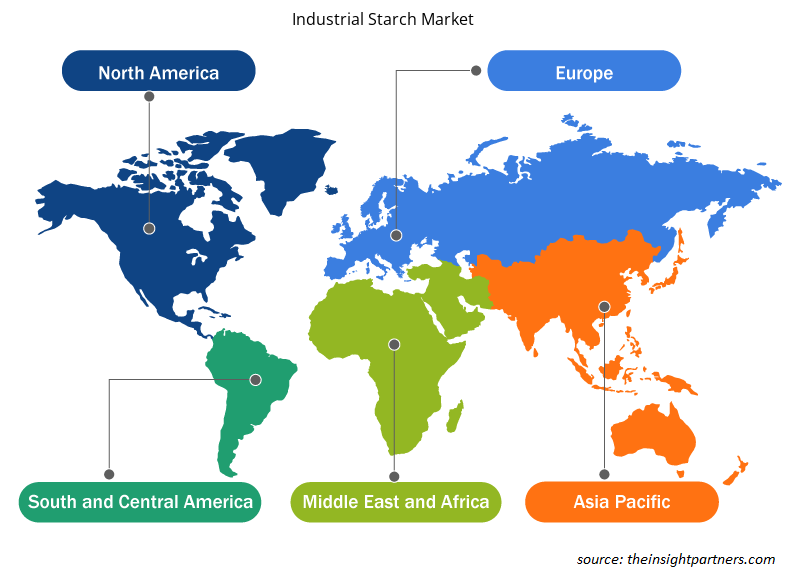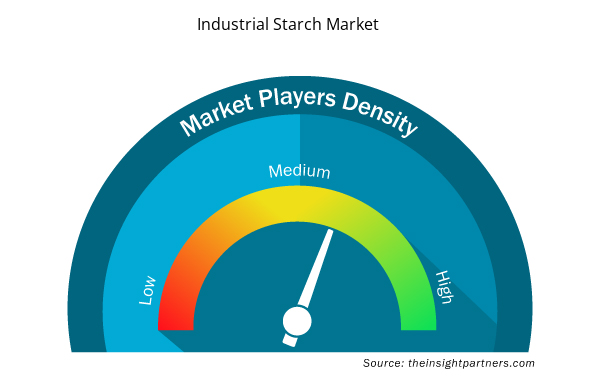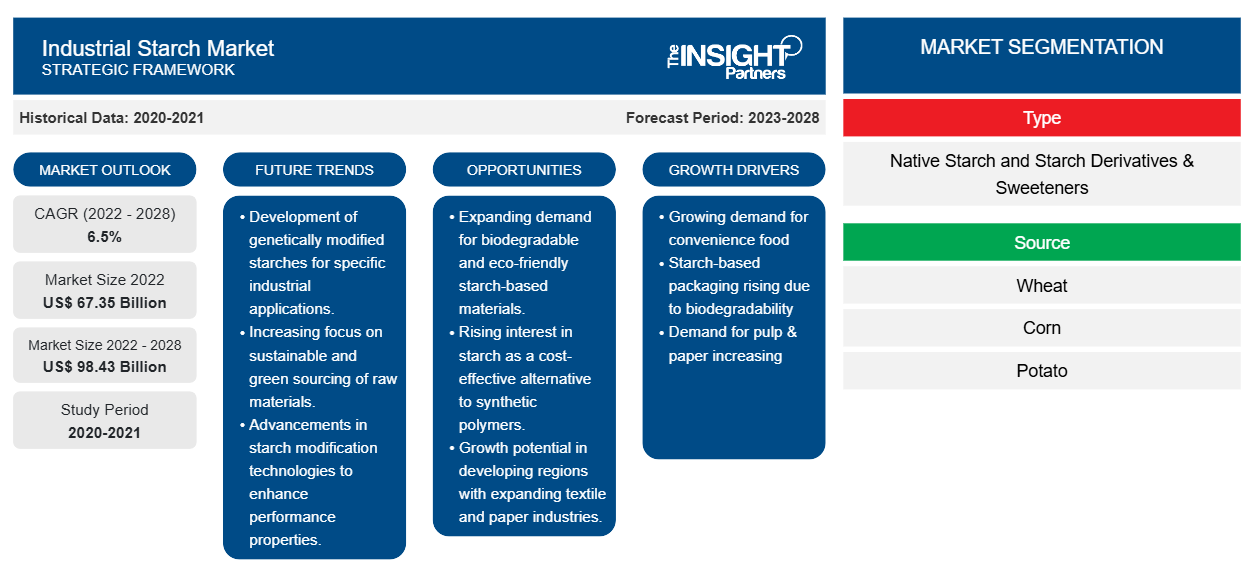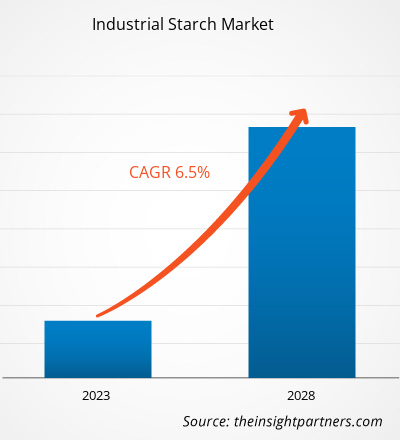[Rapporto di ricerca] Si prevede che il mercato dell'amido industriale crescerà da 67.353,01 milioni di dollari nel 2022 a 98.426,74 milioni di dollari entro il 2028; si stima che crescerà a un CAGR del 6,5% dal 2022 al 2028.
L'amido è un carboidrato complesso derivato da grano, mais, patate, tapioca e riso. È un'ottima fonte di energia. L'amido è un agente addensante/gelificante e stabilizzante in un'ampia gamma di alimenti e bevande, tra cui prodotti da forno e dolciari, zuppe, salse, dessert surgelati, creme di latte e bevande pronte da bere. La domanda di cibi pronti sta aumentando a livello globale a causa dello stile di vita frenetico dei consumatori e dell'elevato reddito pro capite. Inoltre, gli imballaggi alimentari a base di carta necessitano di un rivestimento per impedire all'acqua o all'ossigeno di penetrare nell'imballaggio e rovinare il prodotto alimentare all'interno. Di solito, questo rivestimento protettivo è prodotto da plastica a base di petrolio. Tuttavia, i produttori stanno adottando materie prime biologiche ed ecologiche per il rivestimento degli imballaggi alimentari a base di carta con una crescente consapevolezza dell'impatto negativo della plastica a base di petrolio sull'ambiente. Le caratteristiche degli imballaggi a base di amido come la biodegradabilità e l'accessibilità stanno spingendo la popolarità tra i produttori.
Negli ultimi anni, la domanda di amido nell'industria della carta e della cellulosa è cresciuta in modo significativo con le operazioni su larga scala in questo settore. Il fiorente settore dell'e-commerce contribuisce in modo significativo alla domanda di cartoni ondulati. Inoltre, un notevole spostamento verso imballaggi privi di plastica per garantire la sostenibilità ambientale sta spingendo la domanda di materiali di imballaggio sostenibili. Secondo una ricerca condotta da Roquette Frères, il consumo di amido industriale nella produzione di cartone ondulato è aumentato del 6% nel 2020 a causa del significativo aumento del settore dell'e-commerce durante la pandemia di COVID-19. Pertanto, la crescente domanda di amido nell'industria della carta e del cartone sta rafforzando il mercato dell'amido industriale
Personalizza questo report in base alle tue esigenze
Riceverai la personalizzazione gratuita di qualsiasi report, comprese parti di questo report, o analisi a livello nazionale, pacchetto dati Excel, oltre a usufruire di grandi offerte e sconti per start-up e università
- Scopri le principali tendenze di mercato in questo rapporto.Questo campione GRATUITO includerà analisi di dati che spaziano dalle tendenze di mercato alle stime e alle previsioni.
I produttori di tutto il mondo stanno beneficiando della crescita del settore dell'e-commerce. In tutto il mondo, vari produttori e canali di e-commerce stanno promuovendo l'uso di materiali di imballaggio sostenibili ed ecocompatibili. Si prevede che la crescita del mercato dell'amido industriale aumenterà con questa crescente adozione di materiali di imballaggio sostenibili da parte del settore dell'e-commerce. Le società indiane di e-commerce Myntra e Flipkart hanno adottato misure per ridurre o eliminare l'uso di plastica monouso nei loro materiali di imballaggio. Inoltre, si prevede che le politiche governative per ridurre l'inquinamento da plastica aumenteranno la domanda di amido industriale.benefitting from the growth of the e-commerce industry. Across the globe, various manufacturers and e-commerce channels are promoting the use of sustainable and eco-friendly packaging materials. The industrial starch market growth is expected to boost with this increasing adoption of Myntra and Flipkart have adopted to reduce or eliminate the use of single-use plastic in their packaging materials. Moreover, government policies to reduce plastic pollution is expected to boost the demand for industrial starch.
Approfondimenti di mercato
Ampio campo di applicazione dell'amido industriale alimenta la crescita del mercato
La gamma di applicazioni degli amidi industriali in vari settori di utilizzo finale si è ampliata negli ultimi anni. Viene utilizzato come agente addensante, gelificante e legante in un'ampia gamma di alimenti e bevande, tra cui prodotti da forno, zuppe e condimenti per insalate, dolciumi, salse, gelati , bevande alla frutta e latticini. L'amido viene utilizzato anche in applicazioni non alimentari come cellulosa e carta, prodotti farmaceutici e mangimi per animali. Nell'industria farmaceutica, l'amido viene utilizzato come eccipiente e legante nella produzione di compresse. Inoltre, i materiali a base di amido sono una soluzione perfetta per materiali di imballaggio alimentare biodegradabili che aiutano a ridurre l'inquinamento ambientale.excipient and binding agent in tablet making. Moreover, starch-based materials are a perfect solution for biodegradable food packaging materials that help to reduce environmental pollution.
Tipo Informazioni
In base al tipo, il mercato dell'amido industriale è segmentato in amido nativo e derivati dell'amido e dolcificanti. Nel 2021, il segmento dei derivati dell'amido e dei dolcificanti ha dominato il mercato. La crescente domanda di alimenti e bevande, dovuta all'aumento dei livelli di reddito disponibile e all'aumento della popolazione globale, e l'uso di derivati dell'amido nell'industria alimentare e delle bevande rappresentano il motore di crescita più importante per il segmento dei derivati dell'amido del mercato dell'amido industriale.
Agrana Beteiligungs-AG; ADM; Ingredion Incorporated; Roquette Frères; Tereos Group; Cargill, Incorporated; Tate & Lyle PLC; Grain Processing Corporation; Royal Cosun; e AVEBE sono tra i principali attori che operano nel mercato dell'amido industriale. I principali attori adottano diverse strategie, come fusioni e acquisizioni e lanci di prodotti, per espandere la loro presenza geografica e la base di consumatori. Beteiligungs-AG; ADM; Ingredion Incorporated; Roquette Frères; Tereos Group; Cargill, Incorporated; Tate & Lyle PLC; Grain Processing Corporation; Royal Cosun; and AVEBE are among the key players operating in the industrial starch market. The leading players adopt several strategies, such as mergers & acquisitions and product launches, to expand their geographic presence and consumer base.
Segnala i riflettori
- Tendenze progressive nel settore dell'amido industriale per aiutare gli operatori a sviluppare strategie efficaci a lungo termine
- Strategie di crescita aziendale adottate dalle aziende per garantire la crescita nei mercati sviluppati e in via di sviluppo
- Analisi quantitativa del mercato globale dell'amido industriale dal 2021 al 2028
- Stima della domanda di amido industriale nei vari settori
- Analisi delle cinque forze di Porter per illustrare l'efficacia degli acquirenti e dei fornitori che operano nel settore dell'amido industriale
- Sviluppi recenti per comprendere lo scenario competitivo del mercato e la domanda di amido industriale
- Tendenze e prospettive di mercato, insieme ai fattori che regolano la crescita del mercato dell'amido industriale
- Comprensione delle strategie che sostengono l'interesse commerciale in relazione alla crescita del mercato, aiutando nel processo decisionale
- Dimensioni del mercato dell'amido industriale nei vari nodi del mercato
- Panoramica dettagliata e segmentazione del mercato nonché delle dinamiche del settore
- Dimensioni del mercato dell'amido industriale in varie regioni con promettenti opportunità di crescita
Approfondimenti regionali sul mercato dell'amido industriale
Le tendenze regionali e i fattori che influenzano il mercato dell'amido industriale durante il periodo di previsione sono stati ampiamente spiegati dagli analisti di Insight Partners. Questa sezione discute anche i segmenti e la geografia del mercato dell'amido industriale in Nord America, Europa, Asia Pacifico, Medio Oriente e Africa e America meridionale e centrale.

- Ottieni i dati specifici regionali per il mercato dell'amido industriale
Ambito del rapporto sul mercato dell'amido industriale
| Attributo del report | Dettagli |
|---|---|
| Dimensioni del mercato nel 2022 | 67,35 miliardi di dollari USA |
| Dimensioni del mercato entro il 2028 | 98,43 miliardi di dollari USA |
| CAGR globale (2022 - 2028) | 6,5% |
| Dati storici | 2020-2021 |
| Periodo di previsione | 2023-2028 |
| Segmenti coperti | Per tipo
|
| Regioni e Paesi coperti | America del Nord
|
| Leader di mercato e profili aziendali chiave |
|
Densità degli attori del mercato dell'amido industriale: comprendere il suo impatto sulle dinamiche aziendali
Il mercato dell'amido industriale sta crescendo rapidamente, spinto dalla crescente domanda degli utenti finali dovuta a fattori quali l'evoluzione delle preferenze dei consumatori, i progressi tecnologici e una maggiore consapevolezza dei benefici del prodotto. Con l'aumento della domanda, le aziende stanno ampliando le loro offerte, innovando per soddisfare le esigenze dei consumatori e capitalizzando sulle tendenze emergenti, il che alimenta ulteriormente la crescita del mercato.
La densità degli operatori di mercato si riferisce alla distribuzione di aziende o società che operano in un particolare mercato o settore. Indica quanti concorrenti (operatori di mercato) sono presenti in un dato spazio di mercato in relazione alle sue dimensioni o al valore di mercato totale.
Le principali aziende che operano nel mercato dell'amido industriale sono:
- AGRANA Beteiligungs-AG
- Direttore Generale
- Ingredion Incorporated
- Fratelli Roquette
- Gruppo Tereos
Disclaimer : le aziende elencate sopra non sono classificate secondo un ordine particolare.

- Ottieni una panoramica dei principali attori del mercato dell'amido industriale
"Industrial Starch Market Analysis to 2028" è uno studio specializzato e approfondito del settore chimico e dei materiali, incentrato sull'analisi delle tendenze di mercato. Il rapporto mira a fornire una panoramica del mercato con una segmentazione dettagliata. Il mercato dell'amido industriale è segmentato in base a tipo, fonte, applicazione e geografia. In base al tipo, il mercato dell'amido industriale è segmentato in amido nativo e derivati e dolcificanti dell'amido. In base alla fonte, il mercato è segmentato in grano, mais, patate, manioca e altri. In base all'applicazione, il mercato è segmentato in alimenti e bevande, cellulosa e carta, mangimi per animali, prodotti farmaceutici e altri. In base alla geografia, è segmentato in cinque regioni principali: Nord America, Europa, Asia Pacifico, Medio Oriente e Africa e Sud e Centro America. Nel 2021, l'Asia Pacifico ha dominato il mercato dell'amido industriale.
- Analisi storica (2 anni), anno base, previsione (7 anni) con CAGR
- Analisi PEST e SWOT
- Valore/volume delle dimensioni del mercato - Globale, regionale, nazionale
- Industria e panorama competitivo
- Set di dati Excel



Report Coverage
Revenue forecast, Company Analysis, Industry landscape, Growth factors, and Trends

Segment Covered
This text is related
to segments covered.

Regional Scope
North America, Europe, Asia Pacific, Middle East & Africa, South & Central America

Country Scope
This text is related
to country scope.
Domande frequenti
Growth in the global food and beverage industry and an increase in demand from the packaging industry are drivers of the industrial starch market. The growing population around the world is increasing the demand for the food and beverages industrial starch market. And the significant growth of e-commerce and increasing adoption of eco-friendly packaging material is expected to propel the demand for industrial starch.
The major players operating in the global industrial starch market is AGRANA Beteiligungs-AG; ADM; Ingredion Incorporated.; Roquette Frères; Tereos Group; Cargill, Incorporated Tate & Lyle PLC; Grain Processing Corporation; Royal Cosun; AVEBE.
In 2021, North America accounted for the highest growth of the global industrial starch market. Starch is used as a thickening/gelling agent and stabilizer in a wide range of food and beverages, including bakery and confectionery products, soups, sauces, frozen desserts, dairy creamers, and ready-to-drink beverages. The rising demand for convenience food owing to the hectic lifestyle and high per-capita income of consumers is driving the demand for starch in the food & beverages industry. Veganism and clean-label trends are surging rapidly across the world.
Product innovation in industrial starches is a recent trend in the global industrial starch market. There is a strong demand for products with organic, clean-label, and plant-based ingredients in Europe owing to rising health and wellness concerns. This clean-label product provides instant viscosity, thereby enabling optimal control of rheological behavior in cake mixes, sauces, or other semiliquid formulations. It can also be used to prepare high-quality savory products, pastries, and fruit-based fillings to provide a premium look and texture.
Based on the application pulp and paper segment is leading the market in 2021. As there is a high demand for starch from the papermaking industry in the region due to the rising demand for paper products from the packaging and transportation industries. The booming e-commerce industry in the region is also generating demand for corrugated paper and paperboards, thereby contributing to the industrial starch market progress
Based on the segment type, starch derivatives and sweeteners were the fastest-growing segment in 2021. Starch derivatives and sweeteners are obtained from the further processing of native starch. Usually, native starch is converted into glucose syrup, which is processed to obtain maltodextrins, isoglucose, polyols, and dextrose
The List of Companies - Industrial Starch Market
- AGRANA Beteiligungs-AG
- ADM
- Ingredion Incorporated
- Roquette Frères
- Tereos Group
- Cargill, Incorporated.
- Tate & Lyle PLC
- Grain Processing Corporation
- Royal Cosun
- AVEBE
The Insight Partners performs research in 4 major stages: Data Collection & Secondary Research, Primary Research, Data Analysis and Data Triangulation & Final Review.
- Data Collection and Secondary Research:
As a market research and consulting firm operating from a decade, we have published and advised several client across the globe. First step for any study will start with an assessment of currently available data and insights from existing reports. Further, historical and current market information is collected from Investor Presentations, Annual Reports, SEC Filings, etc., and other information related to company’s performance and market positioning are gathered from Paid Databases (Factiva, Hoovers, and Reuters) and various other publications available in public domain.
Several associations trade associates, technical forums, institutes, societies and organization are accessed to gain technical as well as market related insights through their publications such as research papers, blogs and press releases related to the studies are referred to get cues about the market. Further, white papers, journals, magazines, and other news articles published in last 3 years are scrutinized and analyzed to understand the current market trends.
- Primary Research:
The primarily interview analysis comprise of data obtained from industry participants interview and answers to survey questions gathered by in-house primary team.
For primary research, interviews are conducted with industry experts/CEOs/Marketing Managers/VPs/Subject Matter Experts from both demand and supply side to get a 360-degree view of the market. The primary team conducts several interviews based on the complexity of the markets to understand the various market trends and dynamics which makes research more credible and precise.
A typical research interview fulfils the following functions:
- Provides first-hand information on the market size, market trends, growth trends, competitive landscape, and outlook
- Validates and strengthens in-house secondary research findings
- Develops the analysis team’s expertise and market understanding
Primary research involves email interactions and telephone interviews for each market, category, segment, and sub-segment across geographies. The participants who typically take part in such a process include, but are not limited to:
- Industry participants: VPs, business development managers, market intelligence managers and national sales managers
- Outside experts: Valuation experts, research analysts and key opinion leaders specializing in the electronics and semiconductor industry.
Below is the breakup of our primary respondents by company, designation, and region:

Once we receive the confirmation from primary research sources or primary respondents, we finalize the base year market estimation and forecast the data as per the macroeconomic and microeconomic factors assessed during data collection.
- Data Analysis:
Once data is validated through both secondary as well as primary respondents, we finalize the market estimations by hypothesis formulation and factor analysis at regional and country level.
- Macro-Economic Factor Analysis:
We analyse macroeconomic indicators such the gross domestic product (GDP), increase in the demand for goods and services across industries, technological advancement, regional economic growth, governmental policies, the influence of COVID-19, PEST analysis, and other aspects. This analysis aids in setting benchmarks for various nations/regions and approximating market splits. Additionally, the general trend of the aforementioned components aid in determining the market's development possibilities.
- Country Level Data:
Various factors that are especially aligned to the country are taken into account to determine the market size for a certain area and country, including the presence of vendors, such as headquarters and offices, the country's GDP, demand patterns, and industry growth. To comprehend the market dynamics for the nation, a number of growth variables, inhibitors, application areas, and current market trends are researched. The aforementioned elements aid in determining the country's overall market's growth potential.
- Company Profile:
The “Table of Contents” is formulated by listing and analyzing more than 25 - 30 companies operating in the market ecosystem across geographies. However, we profile only 10 companies as a standard practice in our syndicate reports. These 10 companies comprise leading, emerging, and regional players. Nonetheless, our analysis is not restricted to the 10 listed companies, we also analyze other companies present in the market to develop a holistic view and understand the prevailing trends. The “Company Profiles” section in the report covers key facts, business description, products & services, financial information, SWOT analysis, and key developments. The financial information presented is extracted from the annual reports and official documents of the publicly listed companies. Upon collecting the information for the sections of respective companies, we verify them via various primary sources and then compile the data in respective company profiles. The company level information helps us in deriving the base number as well as in forecasting the market size.
- Developing Base Number:
Aggregation of sales statistics (2020-2022) and macro-economic factor, and other secondary and primary research insights are utilized to arrive at base number and related market shares for 2022. The data gaps are identified in this step and relevant market data is analyzed, collected from paid primary interviews or databases. On finalizing the base year market size, forecasts are developed on the basis of macro-economic, industry and market growth factors and company level analysis.
- Data Triangulation and Final Review:
The market findings and base year market size calculations are validated from supply as well as demand side. Demand side validations are based on macro-economic factor analysis and benchmarks for respective regions and countries. In case of supply side validations, revenues of major companies are estimated (in case not available) based on industry benchmark, approximate number of employees, product portfolio, and primary interviews revenues are gathered. Further revenue from target product/service segment is assessed to avoid overshooting of market statistics. In case of heavy deviations between supply and demand side values, all thes steps are repeated to achieve synchronization.
We follow an iterative model, wherein we share our research findings with Subject Matter Experts (SME’s) and Key Opinion Leaders (KOLs) until consensus view of the market is not formulated – this model negates any drastic deviation in the opinions of experts. Only validated and universally acceptable research findings are quoted in our reports.
We have important check points that we use to validate our research findings – which we call – data triangulation, where we validate the information, we generate from secondary sources with primary interviews and then we re-validate with our internal data bases and Subject matter experts. This comprehensive model enables us to deliver high quality, reliable data in shortest possible time.


 Ottieni un campione gratuito per questo repot
Ottieni un campione gratuito per questo repot